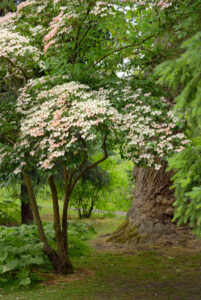You adore flowering dogwoods. You believe anybody could grow them. However, there are times your lovely dogwood doesn’t look so good anymore. Your dogwood tree leaves are an ugly light-brown color. What are you to do? Below are a few common issues and what course of action to take.
Burnt Leaves
Problem: One day, your dogwood appears healthy as a horse. The following day, the leaves are sagging and an unhealthy white-tan color around the edges. This issue typically occurs during the summertime.
Reason: A dogwood tree has shallow roots and can’t endure long spells of dry, hot weather. If the tree ever dries out, the outermost leaves will burn. If the problem isn’t severe, your dogwood will recuperate.
Solution: Apply several layers of mulch around the tree’s bottom. The mulch cools the soil, aiding it in keeping moisture. Examine the leaves frequently during the summer. If you spot wilting leaves, water the tree entirely and quickly.
Spotted Leaves
Problem: Little brown-purple spots cover the leaves. This issue frequently happens to dogwoods budding under tall trees after a spell of rainy weather during the warm months. Diseased leaves dry and stay attached during the wintertime. Cankers developing on the twigs could ultimately girdle and kill the limbs or the whole tree.
Reason: Spot anthracnose is a mycological disease that affects dogwoods. It spreads by water getting on the spores. It’s more of an issue for understory trees than trees out in the open.
Solution:
- Get rid of diseased dogwood tree leaves and branches, throwing them away in the garbage.
- Spray healthy trees and flowers with a fungicide like Daconil.
- Re-apply when you see any leaf spots. You might also want to plant resistant dogwood tree types such as Appalachian Spring.
Powdery Mildew
Problem: A whitish layer covers the leaves. Affected leaves might slump and wither.
Reason: Powdery mildew is a fungus. Various types of mold infect many different plants. This specific fungus likes dogwoods. Powdery mildew usually appears late in the developing season on the new leaves. However, the fungus could appear in the early part of the summer as well. Similar to spot anthracnose, it favors trees growing in bunches beneath tall trees. Also, this mildew prefers rainy, cold weather.
Solution: If powdery mildew appears in late summer, let it be. It won’t do adequate damage to injure the tree. If it comes at the beginning of summer, spray the plant with horticultural oil or neem oil.
No Blooms
Problem: Your dogwood develops appropriately with plenty of green, healthy leaves, just without blooms.
Reason: The usual reasons for dogwood not blooming: low sun (tree develops in the shade, but doesn’t bloom well); tree dried out during the warm months and didn’t establish flower buds; the tree isn’t old enough to bloom; instead of buying a dogwood like “Cherokee Brave,” you purchase one labeled “pink” or “white.” These types might or might not bloom.
Solution:
- Provide blossoming dogwood with at least a half-day of sunshine and some shade in the afternoon.
- Thoroughly water the tree during droughts.
- Pick a dogwood tree known for its excellent display instead of an unnamed tree (white or pink) that might do anything.
To learn more about the different dogwood tree types, call Mechanicsburg Tree Service.


Recent Comments